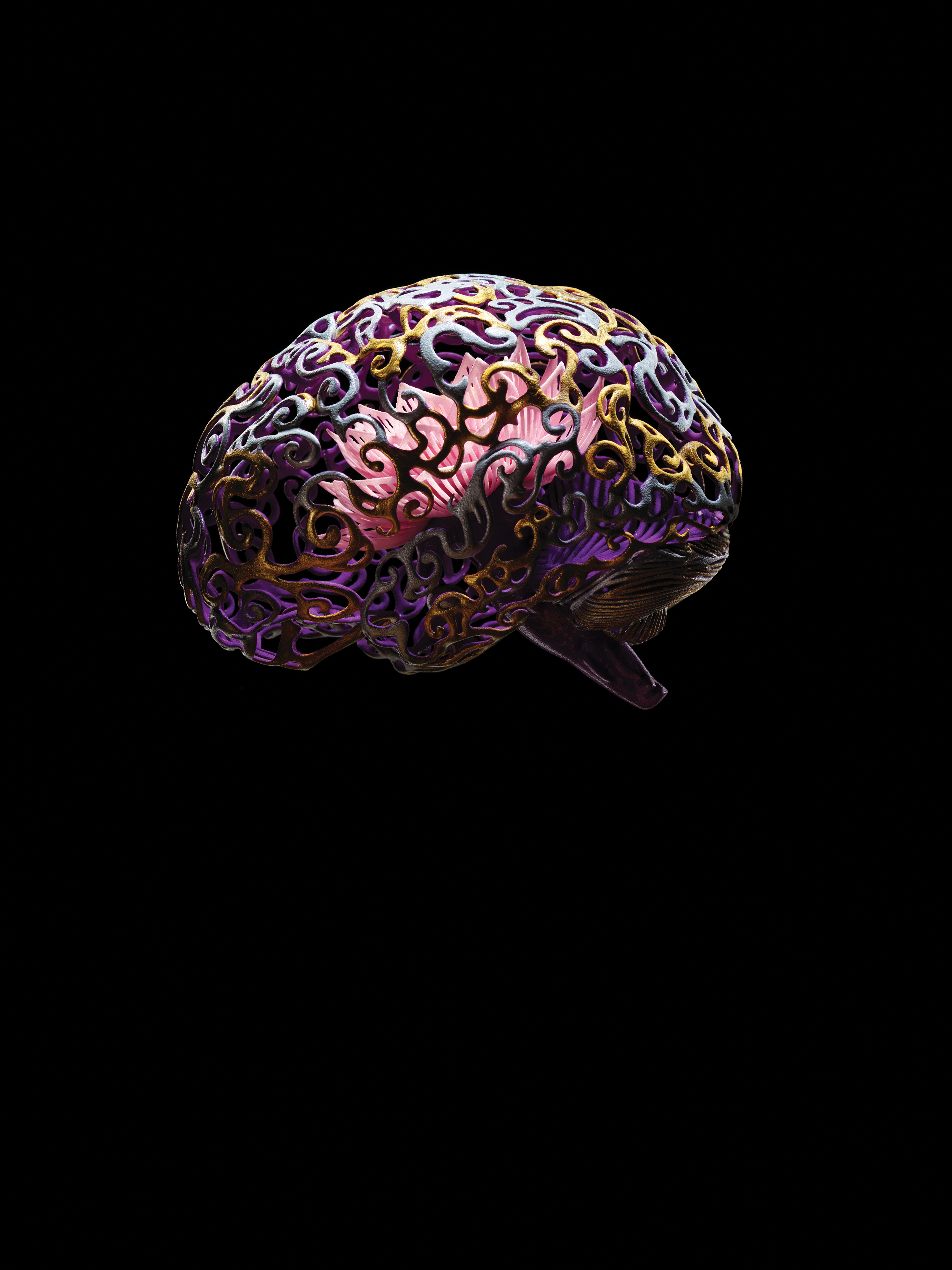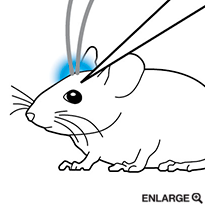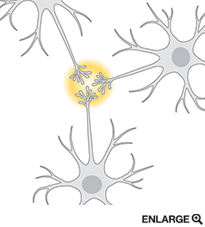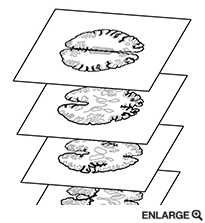Neuroscience’s New Toolbox

What might be called the “make love, not war” branch of behavioral neuroscience began to take shape in (where else?) California several years ago, when researchers in David J. Anderson’s laboratory at Caltech decided to tackle the biology of aggression. They initiated the line of research by orchestrating the murine version of Fight Night: they goaded male mice into tangling with rival males and then, with painstaking molecular detective work, zeroed in on a smattering of cells in the hypothalamus that became active when the mice started to fight.
The hypothalamus is a small structure deep in the brain that, among other functions, coördinates sensory inputs—the appearance of a rival, for example—with instinctual behavioral responses. Back in the 1920s, Walter Hess of the University of Zurich (who would win a Nobel in 1949) had shown that if you stuck an electrode into the brain of a cat and electrically stimulated certain regions of the hypothalamus, you could turn a purring feline into a furry blur of aggression. Several interesting hypotheses tried to explain how and why that happened, but there was no way to test them. Like a lot of fundamental questions in brain science, the mystery of aggression didn’t go away over the past century—it just hit the usual empirical roadblocks. We had good questions but no technology to get at the answers.
By 2010, Anderson’s Caltech lab had begun to tease apart the underlying mechanisms and neural circuitry of aggression in their pugnacious mice. Armed with a series of new technologies that allowed them to focus on individual clumps of cells within brain regions, they stumbled onto a surprising anatomical discovery: the tiny part of the hypothalamus that seemed correlated with aggressive behavior was intertwined with the part associated with the impulse to mate. That small duchy of cells—the technical name is the ventromedial hypothalamus—turned out to be an assembly of roughly 5,000 neurons, all marbled together, some of them seemingly connected to copulating and others to fighting.
“There’s no such thing as a generic neuron,” says Anderson, who estimates that there may be up to 10,000 distinct classes of neurons in the brain. Even tiny regions of the brain contain a mixture, he says, and these neurons “often influence behavior in different, opposing directions.” In the case of the hypothalamus, some of the neurons seemed to become active during aggressive behavior, some of them during mating behavior, and a small subset—about 20 percent—during both fighting and mating.
That was a provocative discovery, but it was also a relic of old-style neuroscience. Being active was not the same as causing the behavior; it was just a correlation. How did the scientists know for sure what was triggering the behavior? Could they provoke a mouse to pick a fight simply by tickling a few cells in the hypothalamus?
A decade ago, that would have been technologically impossible. But in the last 10 years, neuroscience has been transformed by a remarkable new technology called optogenetics, invented by scientists at Stanford University and first described in 2005. The Caltech researchers were able to insert a genetically modified light-sensitive gene into specific cells at particular locations in the brain of a living, breathing, feisty, and occasionally canoodling male mouse. Using a hair-thin fiber-optic thread inserted into that living brain, they could then turn the neurons in the hypothalamus on and off with a burst of light.

Optogenetics: Light Switches for Neurons
Anderson and his colleagues used optogenetics to produce a video dramatizing the love-hate tensions deep within rodents. It shows a male mouse doing what comes naturally, mating with a female, until the Caltech researchers switch on the light, at which instant the murine lothario flies into a rage. When the light is on, even a mild-mannered male mouse can be induced to attack whatever target happens to be nearby—his reproductive partner, another male mouse, a castrated male (normally not perceived as a threat), or, most improbably, a rubber glove dropped into the cage.
“Activating these neurons with optogenetic techniques is sufficient to activate aggressive behavior not only toward appropriate targets like another male mouse but also toward inappropriate targets, like females and even inanimate objects,” Anderson says. Conversely, researchers can inhibit these neurons in the middle of a fight by turning the light off, he says: “You can stop the fight dead in its tracks.”
Moreover, the research suggests that lovemaking overrides war-making in the calculus of behavior: the closer a mouse was to consummation of the reproductive act, the more resistant (or oblivious) he became to the light pulses that normally triggered aggression. In a paper published in Biological Psychiatry, titled “Optogenetics, Sex, and Violence in the Brain: Implications for Psychiatry,” Anderson noted, “Perhaps the imperative to ‘make love, not war’ is hard-wired into our nervous system, to a greater extent than we have realized.” We may be both lovers and fighters, with the slimmest of neurological distances separating the two impulses.
Optogenetics and other new techniques mean scientists can begin to pinpoint the function of the thousands of different types of neurons among the roughly 86 billion in the human brain.
No one is suggesting that we’re on the verge of deploying neural circuit breakers to curb aggressive behavior. But, as Anderson points out, the research highlights a larger point about how a new technology can reinvent the way brain science is done. “The ability of optogenetics to turn a largely correlational field of science into one that tests causation has been transformative,” he says.
What’s radical about the technique is that it allows scientists to perturb a cell or a network of cells with exquisite precision, the key to sketching out the circuitry that affects various types of behavior. Whereas older technologies like imaging allowed researchers to watch the brain in action, optogenetics enables them to influence that action, tinkering with specific parts of the brain at specific times to see what happens.
And optogenetics is just one of a suite of revolutionary new tools that are likely to play leading roles in what looks like a heyday for neuroscience. Major initiatives in both the United States and Europe aspire to understand how the human brain—that tangled three-pound curd of neurons, connective tissue, and circuits—gives rise to everything from abstract thought to basic sensory processing to emotions like aggression. Consciousness, free will, memory, learning—they are all on the table now, as researchers use these tools to investigate how the brain achieves its seemingly mysterious effects (see “Searching for the “Free Will” Neuron”).
Connections
More than 2,000 years ago, Hippocrates noted that if you want to understand the mind, you must begin by studying the brain. Nothing has happened in the last two millennia to change that imperative—except the tools that neuroscience is bringing to the task.
The history of neuroscience, like the history of science itself, is often a story of new devices and new technologies. Luigi Galvani’s first accidental electrode, which provoked the twitch of a frog’s muscle, has inspired every subsequent electrical probe, from Walter Hess’s cat prod to the current therapeutic use of deep brain stimulation to treat Parkinson’s disease (approximately 30,000 people worldwide now have electrodes implanted in their brains to treat this condition). The patch clamp allowed neuroanatomists to see the ebb and flow of ions in a neuron as it prepares to fire. And little did Paul Lauterbur realize, when he focused a strong magnetic field on a single hapless clam in his lab at the State University of New York at Stony Brook in the early 1970s, that he and his colleagues were laying the groundwork for the magnetic resonance imaging (MRI) machines that have helped reveal the internal landscape and activity of a living brain.

Growing Neurons: Studying What Goes Wrong
But it is the advances in genetics and genomic tools during the last few years that have truly revolutionized neuroscience. Those advances made the genetic manipulations at the heart of optogenetics possible. Even more recent genome-editing methods can be used to precisely alter the genetics of living cells in the lab. Along with optogenetics, these tools mean scientists can begin to pinpoint the function of the thousands of different types of nerve cells among the roughly 86 billion in the human brain.
Nothing testifies to the value of a new technology more than the number of scientists who rapidly adopt it and use it to claim new scientific territories. As Edward Boyden, a scientist at MIT who helped develop optogenetics, puts it, “Often when a new technology comes out, there’s a bit of a land grab.”
And even as researchers grab those opportunities in genomics and optogenetics, still other advances are coming on the scene. A new chemical treatment is making it possible to directly see nerve fibers in mammalian brains; robotic microelectrodes can eavesdrop on (and perturb) single cells in living animals; and more sophisticated imaging techniques let researchers match up nerve cells and fibers in brain slices to create a three-dimensional map of the connections. Using these tools together to build up an understanding of the brain’s activity, scientists hope to capture the biggest of cognitive game: memory, decision-making, consciousness, psychiatric illnesses like anxiety and depression, and, yes, sex and violence.
Scientists speculated that if you could smuggle the gene for a light-sensitive protein into a neuron and then pulse the cell with light, you might trigger it to fire. You could turn specific neurons on and off.
In January 2013, the European Commission invested a billion euros in the launch of its Human Brain Project, a 10-year initiative to map out all the connections in the brain. Several months later, in April 2013, the Obama administration announced an initiative called Brain Research through Advanced Innovative Neurotechnologies (BRAIN), which is expected to pour as much as $1 billion into the field, with much of the early funding earmarked for technology development. Then there is the Human Connectome Project, which aims to use electron microscope images of sequential slices of brain tissue to map nerve cells and their connections in three dimensions. Complementary connectome and mapping initiatives are getting under way at the Howard Hughes Medical Institute in Virginia and the Allen Institute for Brain Science in Seattle. They are all part of a large global effort, both publicly and privately funded, to build a comprehensive picture of the human brain, from the level of genes and cells to that of connections and circuits.
Last December, as an initial step in the BRAIN Initiative, the National Institutes of Health solicited proposals for $40 million worth of projects on technology development in the neurosciences. “Why is the BRAIN Initiative putting such a heavy emphasis on technology?” says Cornelia Bargmann, the Rockefeller University neuroscientist who co-directs the planning process for the project. “The real goal is to understand how the brain works, at many levels, in space and time, in many different neurons, all at once. And what’s prevented us from understanding that is limitations in technology.”
Eavesdropping
Optogenetics had its origins in 2000, in late-night chitchat at Stanford University. There, neuroscientists Karl Deisseroth and Edward Boyden began to bounce ideas back and forth about ways to identify, and ultimately manipulate, the activity of specific brain circuits. Deisseroth, who had a PhD in neuroscience from Stanford, longed to understand (and someday treat) the mental afflictions that have vexed humankind since the era of Hippocrates, notably anxiety and depression (see “Shining Light on Madness”). Boyden, who was pursuing graduate work in brain function, had an omnivorous curiosity about neurotechnology. At first they dreamed about deploying tiny magnetic beads as a way to manipulate brain function in intact, living animals. But at some point during the next five years, a different kind of light bulb went off.
Since the 1970s, microbiologists had been studying a class of light-sensitive molecules known as rhodopsins, which had been identified in simple organisms like bacteria, fungi, and algae. These proteins act like gatekeepers along the cell wall; when they detect a particular wavelength of light, they either let ions into a cell or, conversely, let ions out of it. This ebb and flow of ions mirrors the process by which a neuron fires: the electrical charge within the nerve cell builds up until the cell unleashes a spike of electrical activity flowing along the length of its fiber (or axon) to the synapses, where the message is passed on to the next cell in the pathway. Scientists speculated that if you could smuggle the gene for one of these light-sensitive proteins into a neuron and then pulse the cell with light, you might trigger it to fire. Simply put, you could turn specific neurons in a conscious animal on—or off—with a burst of light.
In 2004, Deisseroth successfully inserted the gene for a light-sensitive molecule from algae into mammalian neurons in a dish. Deisseroth and Boyden went on to show that blue light could induce the neurons to fire. At about the same time, a graduate student named Feng Zhang joined Deisseroth’s lab. Zhang, who had acquired a precocious expertise in the techniques of both molecular biology and gene therapy as a high school student in Des Moines, Iowa, showed that the gene for the desired protein could be introduced into neurons by means of genetically engineered viruses. Again using pulses of blue light, the Stanford team then demonstrated that it could turn electrical pulses on and off in the virus-modified mammalian nerve cells. In a landmark paper that appeared in Nature Neuroscience in 2005 (after, Boyden says, it was rejected by Science), Deisseroth, Zhang, and Boyden described the technique. (No one would call it “optogenetics” for another year.)
Neuroscientists immediately seized on the power of the technique by inserting light-sensitive genes into living animals. Researchers in Deisseroth’s own lab used it to identify new pathways that control anxiety in mice, and both Deisseroth’s team and his collaborators at Mount Sinai Hospital in New York used it to turn depression on and off in rats and mice. And Susumu Tonegawa’s lab at MIT recently used optogenetics to create false memories in laboratory animals.
When I visited Boyden’s office at MIT’s Media Lab last December, the scientist called up his favorite recent papers involving optogenetics. In a rush of words as rapid as his keystrokes, Boyden described second-generation technologies already being developed. One involves eavesdropping on single nerve cells in anesthetized and conscious animals in order to see “the things roiling underneath the sea of activity” within a neuron when the animal is unconscious. Boyden said, “It literally sheds light on what it means to have thoughts and awareness and feelings.”
Scientists often employ words like “surprising” and “unexpected” to characterize recent results, reflecting the impact optogenetics has had on the understanding of psychiatric illnesses.
Boyden’s group had also just sent off a paper reporting a new twist on optogenetics: separate, independent neural pathways can be perturbed simultaneously with red and blue wavelengths of light. The technique has the potential to show how different circuits interact with and influence each other. His group is also working on “insanely dense” recording probes and microscopes that aspire to capture whole-brain activity. The ambitions are not modest. “Can you record all the cells in the brain,” he says, “so that you can watch thoughts or decisions or other complex phenomena emerge as you go from sensation to emotion to decision to action site?”

Brain Mapping: Charting the Information Superhighways
A few blocks away, Feng Zhang, who is now an assistant professor at MIT and a faculty member at the Broad Institute, listed age-old neuroscience questions that might now be attacked with the new technologies. “Can you do a memory upgrade and increase the capacity?” he asked. “How are neural circuits genetically encoded? How can you reprogram the genetic instructions? How do you fix the genetic mutations that cause miswiring or other malfunctions of the neural system? How do you make the old brain younger?”
In addition to helping to invent optogenetics, Zhang played a central role in developing a gene-editing technique called CRISPR (see “10 Breakthrough Technologies: Genome Editing,” May/June). The technology allows scientists to target a gene—in neurons, for example—and either delete or modify it. If it’s modified to include a mutation known or suspected to cause brain disorders, scientists can study the progression of those disorders in lab animals. Alternatively, researchers can use CRISPR in the lab to alter stem cells that can then be grown into neurons to see the effects.
Transparency
Back at Stanford, when he’s not seeing patients with autism spectrum disorders or depression in the clinic, Deisseroth continues to invent tools that he and others can use to study these conditions. Last summer, his lab reported a new way for scientists to visualize the cables of nerve fibers, known as “white matter,” that connect distant precincts of the brain. The technique, called Clarity, first immobilizes biomolecules such as protein and DNA in a plastic-like mesh that retains the physical integrity of a postmortem brain. Then researchers flush a kind of detergent through the mesh to dissolve all the fats in brain tissue that normally block light. The brain is rendered transparent, suddenly exposing the entire three-dimensional wiring pattern to view.
Together, the new tools are transforming many conventional views in neuroscience. For example, as Deisseroth noted in a review article published earlier this year in Nature, optogenetics has challenged some of the ideas underlying deep brain stimulation, which has been widely used to treat everything from tremors and epilepsy to anxiety and obsessive-compulsive disorder. No one knows just why it works, but the operating assumption has been that its therapeutic effects derive from electrical stimulation of very specific brain regions; neurosurgeons exert extraordinary effort to place electrodes with the utmost precision.
In 2009, however, Deisseroth and colleagues showed that specifically stimulating the white matter, the neural cables that happen to lie near the electrodes, produced the most robust clinical improvement in symptoms of Parkinson’s disease. In other words, it wasn’t the neighborhood of the brain that mattered so much as which neural highways happened to pass nearby. Scientists often employ words like “surprising” and “unexpected” to characterize such recent results, reflecting the impact that optogenetics has had on the understanding of psychiatric illness.
In the same vein, Caltech’s Anderson points out that the public and scientific infatuation with functional MRI studies over the last two decades has created the impression that certain regions of the brain act as “centers” of neural activity—that the amygdala is the “center” of fear, for example, or the hypothalamus is the “center” of aggression. But he likens fMRI to looking down on a nighttime landscape from an airplane at 30,000 feet and “trying to figure out what is going on in a single town.” Optogenetics, by contrast, has provided a much more detailed view of that tiny subdivision of cells in the hypothalamus, and thus a much more complex and nuanced picture of aggression. Activating specific neurons in that little town can tip an organism to make war, but activating the neurons next door can nudge it to make love.
The new techniques will give scientists the first glimpses of human cognition in action—a look at how thoughts, feelings, forebodings, and dysfunctional mental activity arise from the neural circuitry and from the activity of particular types of cells. Researchers are just beginning to gain these insights, but given the recent pace of technology development, the picture might emerge sooner than anyone dreamed possible when the light of optogenetics first flickered on a few years ago.
Stephen S. Hall is a science writer and author in New York City. His last feature for MIT Technology Review was “Repairing Bad Memories.”
Keep Reading
Most Popular
Large language models can do jaw-dropping things. But nobody knows exactly why.
And that's a problem. Figuring it out is one of the biggest scientific puzzles of our time and a crucial step towards controlling more powerful future models.
How scientists traced a mysterious covid case back to six toilets
When wastewater surveillance turns into a hunt for a single infected individual, the ethics get tricky.
The problem with plug-in hybrids? Their drivers.
Plug-in hybrids are often sold as a transition to EVs, but new data from Europe shows we’re still underestimating the emissions they produce.
Stay connected
Get the latest updates from
MIT Technology Review
Discover special offers, top stories, upcoming events, and more.